
The Royal Norwegian Navy is the branch of the Norwegian Armed Forces responsible for naval operations of Norway. As of 2008, the Royal Norwegian Navy consists of approximately 3,700 personnel and 70 vessels, including 4 heavy frigates, 6 submarines, 14 patrol boats, 4 minesweepers, 4 minehunters, 1 mine detection vessel, 4 support vessels and 2 training vessels. It also includes the Coast Guard.
HNoMS Valkyrien, HNoMS Valkyrjen has been the name of several ships in the Royal Norwegian Navy. Most of them have been in some way connected to the Royal Norwegian Navy's torpedo boats. The name honours the valkyries of Norse mythology. It has also been said that the ships have been given this name in honour of all women. Some of the ships:

SS Polarlys was a Hurtigruten coastal passenger/cargo steamer built in 1912. She was seized by the Germans during the Second World War, and served several stints in the Kriegsmarine. Having resumed her Hurtigruten service after the war until 1951, and in 1952 she was renamed Sylvia. At the same year, she was transferred to the Royal Norwegian Navy, and served under the name HNoMS Valkyrien as a motor torpedo boat tender between 1953 and 1963.
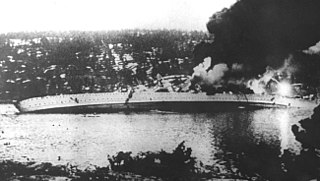
The Battle of Drøbak Sound took place in Drøbak Sound, the northernmost part of the outer Oslofjord in southern Norway, on 9 April 1940. It marked the end of the "Phoney War" and the beginning of World War II in Western Europe.

The Draug class was the first multi-vessel class of destroyers built for the Royal Norwegian Navy in the early 20th century and the first destroyers constructed for the Royal Norwegian Navy since Valkyrjen, which was commissioned on 17 May 1896. The class comprised three ships, Draug, Troll and Garm. All three were built at the naval shipyard at Horten. The Draug class were the last Norwegian-constructed destroyers until the Aalesund class was laid down in 1939. The Draug class saw service until the 1940s. In 1940, Garm was sunk while the other two remained in service until sold and broken up for scrap.

HNoMS Garm was the third destroyer built for the Royal Norwegian Navy, and was a Draug class destroyer. Garm was constructed several years after her two sister ships, but to the same plans. She was built at the naval shipyard in Horten, with yard number 107.
The HNoMS Gor was a Gor-class Rendel gunboat built for the Royal Norwegian Navy at Karljohansvern Naval Yard in Horten in 1884. She was one of a class of two gunboats - the other ship in her class being Tyr. The Gor and Tyr can be seen as improved Vale-class gunboats.
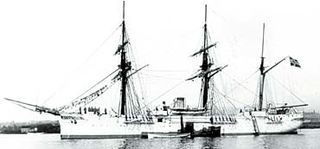
HNoMS Ellida was a 1. class gunboat built for the Royal Norwegian Navy. Like the other Norwegian gunships of her era, she carried a reasonable heavy armament on a diminutive hull. A distinct feature of Ellida was that her funnel could be raised and lowered as needed. The vessel was built at the Naval Yard at Horten, and had yard number 59.

The minelayer HNoMS Olav Tryggvason was built by the naval shipyard at Horten in the early 1930s and had build number 119. She served in the Royal Norwegian Navy until captured by the Germans in 1940. The Germans renamed her first Albatros II, and a few days later Brummer. She was wrecked in a British bombing raid in northern Germany in April 1945.
German submarine U-735 was a Type VIIC U-boat built for Nazi Germany's Kriegsmarine for service during World War II.
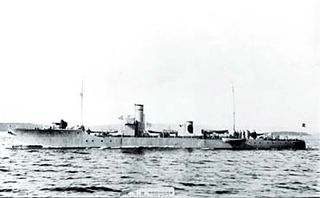
The last of the Trygg class of Royal Norwegian Navy torpedo boats was HNoMS Stegg. Her sister ships were Trygg and Snøgg. The Trygg class vessels were the only additions to the Norwegian fleet of torpedo boats between the First and the Second World Wars. At the outbreak of the Second World War the Trygg class was mobilised together with eight 2. class and six 1. class torpedo boats.

The Trygg class was the third and last class of torpedo boats to be built for the Royal Norwegian Navy. The three Trygg ships were constructed from 1919 to 1921 at Moss Verft in Moss (Trygg) and Horten naval yard.

The Gorgon-class monitors were a class of monitors in service with the Royal Navy during World War I. Gorgon and her sister ship Glatton were originally built as coastal defence ships for the Royal Norwegian Navy, as HNoMS Nidaros and HNoMS Bjørgvin respectively but requisitioned for British use. Gorgon commissioned first, in June 1918 and bombarded German positions and other targets in Occupied Flanders. She fired the last shots of the war by the Royal Navy into Belgium on 15 October 1918. She was offered for sale after the war, but was used as a target ship when there were no takers. She was sold for scrap in 1928. Glatton was destroyed by a magazine explosion only days after she was completed in September 1918 while in Dover Harbour. She remained a hazard to shipping until the wreck was partially salvaged and the remains moved out of the way during 1925–26.
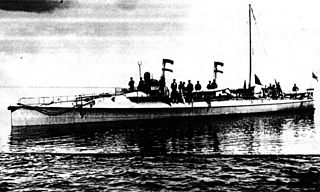
HNoMS Sæl was the penultimate vessel of the ten 1. class torpedo boats of the Royal Norwegian Navy. She was built at the Royal Norwegian Navy Shipyard in Horten in 1901, with yard number 85. She was to see close to 40 years service with the Royal Norwegian Navy, taking part in the preparations for war in connection with the dissolution the union with Sweden in 1905, enforcing Norwegian neutrality during the First World War and opposing the German invasion of Norway in 1940. She was lost in battle with Kriegsmarine vessels at Ånuglo in the Hardangerfjord on 18 April 1940.
HNoMS Tor was a Sleipner-class destroyer of the Royal Norwegian Navy that was launched in September 1939. She was under outfitting and testing when Nazi Germany invaded Norway on 9 April 1940. Although scuttled by Norwegian naval personnel to prevent her from being captured by the invading forces, she was soon salvaged by the Germans and put into service with the Kriegsmarine. Under the name Tiger she served out the war as an escort and training vessel, being recovered by the Norwegians in Denmark after the German capitulation in 1945. After the war she was converted to a frigate and served until 1959.
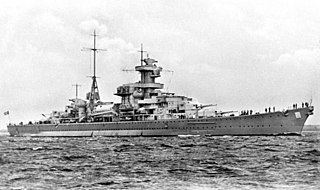
Blücher was the second of five Admiral Hipper-class heavy cruisers of Nazi Germany's Kriegsmarine, built after the rise of the Nazi Party and the repudiation of the Treaty of Versailles. Named for Gebhard Leberecht von Blücher, the Prussian victor of the Battle of Waterloo, the ship was laid down in August 1936 and launched in June 1937. She was completed in September 1939, shortly after the outbreak of World War II. After completing a series of sea trials and training exercises, the ship was pronounced ready for service with the fleet on 5 April 1940. She was armed with a main battery of eight 20.3 cm (8.0 in) guns and, although nominally under the 10,000-long-ton (10,000 t) limit set by the Anglo-German Naval Agreement, actually displaced over 16,000 long tons (16,000 t).

HNoMS Storm was a 1.-class torpedo boat constructed in 1898. Storm served the Royal Norwegian Navy for almost 42 years, including neutrality protection duties during the First World War. She was lost in the 1940 Norwegian campaign of the Second World War. During the Norwegian Campaign, she was the only Norwegian warship that launched a torpedo against the invading Germans.

HMS Recruit was a Clydebank three-funnel, 30-knot destroyer ordered by the Royal Navy under the 1895–1896 Naval Estimates. She was the fifth ship to carry this name since it was introduced in 1806 for an 18-gun brig-sloop, sold in 1822.

Albatros was the fourth of six Type 23 torpedo boats built for the German Navy. Completed in 1927, Albatros often served as a flagship of torpedo boat units. The ship made multiple non-intervention patrols during the Spanish Civil War in the late 1930s. After an attack by aircraft of the Spanish Republican Air Force killed German sailors in 1937, she participated in the retaliatory bombardment of Almería.

Peleng-i Derya was an Ottoman gunboat that was torpedoed by HMS E11 in shallow water off Istanbul, Ottoman Empire on 23 May 1915.
















